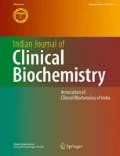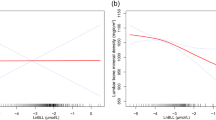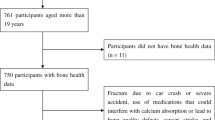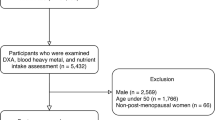Abstract
Lead exposure is increasingly becoming an important risk factor for osteoporosis. In adults, approximately 80–90 % of absorbed lead is stored in the bones. These bone lead deposits are released into the blood during periods of enhanced bone resorption like menopause, forming a potential endogenous source of lead exposure. Postmenopausal women are at a higher risk for bone lead release because of hormonal and age related changes in bone metabolism. Estrogen deficiency is associated with increase in osteoclasts number and activity leading to both the early and late form of osteoporosis. Hence, high blood lead level coupled with concomitant environmental exposure exposes women in this age group to lead related adverse outcomes like hypertension, reduced kidney and neurocognitive functions as well as increased risk of atherosclerosis and cardiovascular mortality. A few studies have also identified coexisting variates like ethnicity, occupation, residence, education, smoking, alcohol medications, water etc. as significant determinants of bone and blood lead in women, thus increasing the magnitude of postmenopausal bone changes. Hence, interventions focused on reducing the intensity of bone resorption during menopause will help decrease exposure to endogenous lead. This would play a significant role in decreasing the morbidity and mortality associated with menopause. Also, identification of modifiable factors that prevent bone lead release will reduce the risk of chronic lead exposure and improve the health outcomes of post-menopausal women.
Similar content being viewed by others
References
Weitzmann MN, Pacifici R. Estrogen deficiency and bone loss: an inflammatory tale. J Clin Invest. 2006;116(5):1186–94.
Lindsay R. Estrogen deficiency. In: Riggs BL, Melton LJ, editors. Osteoporosis: etiology, diagnosis, and management. 2nd ed. Philadelphia: Lippincott-Raven; 1996. p. 133–60.
Cervellati C, Bonaccorsi G, Cremonini E, Romani A, Fila E, Castaldini MC, et al. Oxidative stress and bone resorption interplay as a possible trigger for postmenopausal osteoporosis. Biomed Res Int. 2014. doi:10.1155/2014/569563.
Rigg BL. The mechanisms of estrogen regulation of bone resorption. J Clin Invest. 2000;106(10):1203–4.
Escribano A, Revilla M, Hernandez ER, Seco C, Gonzalez-Riola J, Villa LF, et al. Effect of lead on bone development and bone mass: a morphometric, densitometric and histomorphometric study in growing rats. Calcif Tissue Int. 1997;60(2):200–3.
Gruber HE, Gonick HC, Khalil-Manesh F, Sanchez TV, Motsinger S, Meyer M, et al. Osteopenia induced by long-term, low- and high-level exposure of the adult rat to lead. Miner Electrol Metab. 1997;23(2):65–73.
Ronis MJ, Aronson J, Gao GG, Hogue W, Skinner RA, Badger TM, et al. Skeletal effects of developmental lead exposure in rats. Toxicol Sci. 2001;62:321–9.
Patrick L. Lead toxicity, a review of the literature. Part 1: exposure, evaluation and treatment. Altern Med Rev. 2006;11(1):2–22.
Sharp DS, Becker CE, Smith AH. Chronic low-level lead exposure: its role in the pathogenesis of hypertension. Med Toxicol. 1987;2:210–32.
Hertz-Picciotto I, Croft J. Review of the relation between blood lead and blood pressure. Epidemiol Rev. 1993;15:352–73.
Hu H, Aro A, Payton M, Korrick S, Sparrow D, Weiss ST, et al. The relationship of bone and blood lead to hypertension: the Normative Aging Study. JAMA. 1996;275:1171–6.
Nash D, Magder L, Lustberg M, Sherwin RW, Rubin RJ, Kaufmann RB, et al. Blood lead, blood pressure, and hypertension in perimenopausal and postmenopausal women. JAMA. 2003;289:1523–32.
Kim R, Rotnitsky A, Sparrow D, Weiss S, Wager C, Hu H. A longitudinal study of low-level lead exposure and impairment of renal function: the Normative Aging Study. JAMA. 1996;275:1177–81.
Muldoon SB, Cauley JA, Kuller LH, Morrow L, Needleman HL, Scott J, et al. Effects of blood lead levels on cognitive function of older women. Neuroepidemiology. 1996;15:62–72.
Payton M, Riggs KM, Spiro A 3rd, Weiss ST, Hu H. Relations of bone and blood lead to cognitive function: the VA Normative Aging Study. Neurotoxicol Teratol. 1998;20:19–27.
Lustberg M, Silbergeld E. Blood lead levels and mortality. Arch Intern Med. 2002;162:2443–9.
Campbell JR, Auinger P. The association between blood lead levels and osteoporosis among adults—results from the Third National Health and Nutrition Examination Survey (NHANES III). Environ Health Perspect. 2007;115:1018–22.
Nash D, Magder LS, Sherwin R, Rubin RJ, Silbergeld EK. Bone density-related predictors of blood lead level among peri- and postmenopausal women in the United States, the Third National Health and Nutrition Examination Survey, 1988–1994. Am J Epidemiol. 2004;160:901–11.
Silbergeld EK, Schwartz J, Mahaffey K. Lead and osteoporosis: mobilization of lead from bone in postmenopausal women. Environ Res. 1988;47(1):79–94.
Korrick SA, Schwartz J, Tsaih SW, Hunter DJ, Aro A, Rosner B, et al. Correlates of bone and blood lead levels among middle-aged and elderly women. Am J Epidemiol. 2002;156(4):335–43.
Romero Barco CM, Arija SM, Pérez MR. Biochemical markers in osteoporosis: usefulness in clinical practice. Reumatol Clin. 2012;8:149–52.
Rogers A, Hannon RA, Eastell R. Biochemical markers as predictors of rates of bone loss after menopause. J Bone Miner Res. 2000;15(7):1398–404.
Agrawal S, Jain A, Mahajan D, Raghunandan C. Correlation of bone mineral density with biochemical markers in post-menopausal women. Indian J Clin Biochem. 2009;24(3):262–5.
Jackson LW, Cromer BA, Panneerselvamm A. Association between bone turnover, micronutrient intake, and blood lead levels in pre- and postmenopausal women, NHANES 1999–2002. Environ Health Perspect. 2010;118(11):1590–6.
Hysi L, Rexha T. The use of biochemical markers of bone turnover in the diagnosis of postmenopausal osteoporosis. J Int Acad Res Multidiscip. 2014;2(5):462–7.
Reginster J-Y, Henrotin Y, Christiansen C, Gamwell-Henriksen E, Bruyere O, Collette J, et al. Bone resorption in post-menopausal women with normal and low BMD Assessed with biochemical markers specific for telopeptide derived degradation products of collagen type I. Calcif Tissue Int. 2001;69:130–7.
Silbergeld EK, Schwartz J, Mahaffey K. Lead and osteoporosis: mobilization of lead from bone in postmenopausal women. Environ Res. 1988;47:79–94.
Muldoon SB, Cauley JA, Kuller LH, Scott J, Rohay J. Lifestyle and sociodemographic factors as determinants of blood lead levels in elderly women. Am J Epidemiol. 1994;139:599–608.
Symanski E, Hertz-Picciotto I. Blood lead levels in relation to menopause, smoking, and pregnancy. Am J Epidemiol. 1995;141:1047–58.
Hense HW, Filipiak B, Novak L, Stoeppler M. Non occupational determinants of blood lead concentrations in a general population. Int J Epidemiol. 1992;21:753–62.
Lin C, Kim R, Tsaih SW, Sparrow D, Hu H. Determinants of bone and blood lead levels among minorities living in the Boston area. Environ Health Perspect. 2004;112:1147–51.
Sowers MR, Greendale GA, Bondarenko I, Finkelstein JS, Cauley JA, Neer RM, et al. Endogenous hormones and bone turnover markers in pre and perimenopausal women: SWAN. Osteoporos Int. 2003;14:191–7.
Brown MJ, Hu H, Gonzales-Cossio T, Peterson KE, Sanin LH, de Luz KM, et al. Determinants of bone and blood lead concentrations in the early postpartum period. Occup Environ Med. 2000;57:535–41.
Potula V, Kaye W. The impact of menopause and lifestyle factors on blood and bone lead levels among female former smelter workers: the Bunker Hill Study. Am J Ind Med. 2006;49(3):143–52.
Vishwanath P, Prashant A, Devanand D, Nayak N, D’Souza V, Venkatesh T. Screening of school children for blood lead levels and attempts to reduce them by nonpharmacological means in a coastal city of India. Indian J Med Sci. 2008;62:185–92.
Vishwanath P, Devegowda D, Prashant A, Nayak N, D’Souza V, Venkatesh T, et al. Environmental lead levels in a coastal city of India: the lead burden continues. Indian J Med Sci. 2012;66:260–6.
Jain NB, Hu H. Childhood correlates of blood lead levels in Mumbai and Delhi. Environ Health Perspect. 2006;114:466–70.
Mohan VR, Sharma S, Ramanujam K, Babji S, Koshy B, Bondu JD, et al. Effects of elevated blood lead levels in preschool children in urban Vellore. Indian Pediatr. 2014;51:621–5.
Patel AB, Williams SV, Frumkin H, Kondawar VK, Glick H, Ganju AK. Blood lead in children and its determinants in Nagpur India. Int J Occup Environ Health. 2001;7(2):119–26.
Author information
Authors and Affiliations
Corresponding author
Rights and permissions
About this article
Cite this article
Manocha, A., Srivastava, L.M. & Bhargava, S. Lead as a Risk Factor for Osteoporosis in Post-menopausal Women. Ind J Clin Biochem 32, 261–265 (2017). https://doi.org/10.1007/s12291-016-0610-9
Received:
Accepted:
Published:
Issue Date:
DOI: https://doi.org/10.1007/s12291-016-0610-9




